STRUCTURE OF THE EARTH.
TOPIC OBJECTIVES;
- The student should be able to:
- Identify concentric zones of the earth.
- Account for the variation in density and thickness of the concentric zones of the earths crust.
- Describe the characteristics of the earths crust, the mantle and the core
- Identify types of rocks of the earths crust,
- Explain the mode of formation for each type of rocks and their economic importance.
- To describe the geological time scale.
KEY TERMS AND CONCEPTS.
- Earth- This is the planet supports
- Crust- This is the outer most layer of the earth
- SIAL- Layer of the earth that consists of silica and aluminium
- SIMA-Layer of the crust that consist of silica and Magnesium
- Mohorovic Discontinuity- This is layer between crust and the mantle
- Gutenberg discontinuity-This is a layer which separates between the mantle and the core.
- CONRAD-This is a layer that separated between sial and sima
- TROPOPAUSE- This is a layer that separates troposphere and stratosphere.
- STRATOPAUSE- This is a layer that separates stratosphere and mesosphere
- MESOPAUSE-Is a layer that separates mesosphere and thermosphere
The earth is the third planet in the solar system which is believed to support life.
PARTS OF THE EARTH
The earth consists of two parts;
a) Internal structure of the earth
b) External structure of the earth
A. INTERNAL STRUCTURE OF THE EARTH.
The internal structure of the earth consists of different layers; these are
a) The crust
b) The mantle
c) The core.
A. THE CRUST
The crust is the outermost layer of the earth. It is referred to as LITHOSPHERE. Litho means outer while sphere means layer or shell.
The crust is formed by two parts these are;
a) Upper layer
b) Inner layer
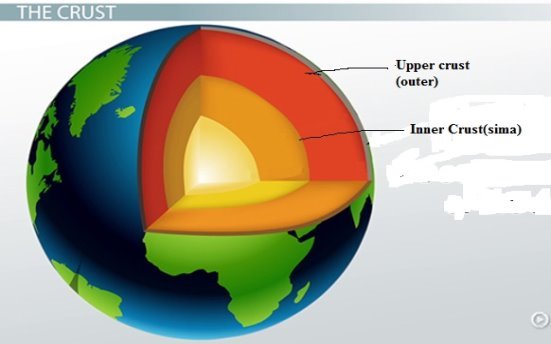
The minerals found in the earth’s crust are Silica, Aluminum and Magnesium.
The outer crust referred to as the SIAL while the inner crust is called the SIMA.
Parts of the Earth’s Crust.
a) SIAL- This is the outer most upper layer of the earth crust. It is composed of minerals such as silica and alumina.
SIAL forms continental floor where human live.
b) SIMA: Is the inner part of the earth’s crust. It is composed of minerals such as silica and magnesium.
Sima forms the floor where aquatic organism live like fish and crocodiles
NB;The layer which separates between the crust and the mantle is referred to as Mohorovicic discontinuity.
The layer was discovered by a Yugoslavian geologist called Mohorovic in 1909.
B. THE MANTLE
The mantle is the interior part of the earth lying between the crust and the core.
The mantle is formed by two parts which are;
a) Upper layer and
b) Lower mantle.
The upper mantle is made up of dense igneous rocks of iron, silicon, magnesium and alluminium
The layer which separate between the mantle and the core is called Gutenberg Discontinuity
c) THE CORE.
The core is the central part of the earths interior. It consists of very dense rocks of nicke and iron(NIFE)
The core is formed by two parts i) The outer layer ii) The inner core
The outer layer core is referred to as barysphere while the inner core is referred to as centrospheres.
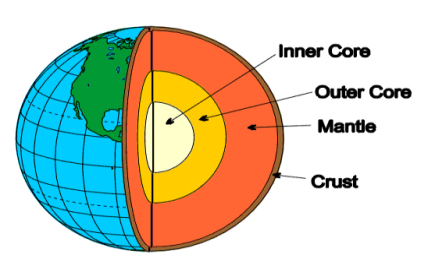 The layer that separates between sial and sima is called CONRAD DISCONTINUITY
The layer that separates between sial and sima is called CONRAD DISCONTINUITY
2. EXTERNAL STRUCTURE OF THE EARTH.
The external structure of the earth comprises of three parts; These are as follows;
a) The earth’s surface
b)Hydrosphere
c) Atmosphere.
A. THE SURFACE OF THE EARTH.
The earth’s surface is composed of water bodies and land surface.
Water surface composed of different water bodies like ponds, lakes, river, oceansm sea, wells, and ditches. Water bodies occupy 70.8% or 71% of all parts of the earth.
Land surface composed of different land forms like mountain plateaus, hills, valleys and plains. These occupy about 29% of all parts of the earth.
B. HYDROSPHERE
Hydro means water
Sphere means layer or shell
So hydrosphere is the layer of the earth which is formed by different water bodies like oceans, seas, lakes and rivers.
Hydrosphere covers about 71% of the earth. Hydrosphere is the home of different plants and animals.
C. ATMOSPHERE
This is the layer of the earth’s surface which is composed of different gases like oxygen, hydrogen, carbon dioxide, nitrogen, argon and helium.
Atmosphere is very thin layer of gases that surround the earth.
LAYERS OF THE ATMOSPHERE
The atmosphere is divided into five layers as going to be explained below;
- Troposphere
- Stratosphere
- Mesosphere
- Thermosphere
- Exosphere
- Lonosphere.
i) TROPOSPHERE
This is the lowest layer of the atmosphere. It is found from 0 to 12 km and it contains 75% of the gases of the in the atmosphere. In the troposphere is where we human beings live and where weather ocuurs.
In the troposphere height increases with decrease of the atmosphere. The layer which separates troposphere and stratosphere is called TROPOPAUSE.
At this layer called tropopause is where we find JETSREAM and the temperature remains constantly fair.
Jet stream- are very strong winds that blow eastward
ii) STRATOSPHERE
This is the second layer in the atmosphere. It os found from 12km to 50km.
Stratosphere contains Ozone layer which is a layer in the atmosphere which acts as a shield for the earth’s surface. Ozone layer absorbs ultra-violet radiation from the sun. This causes the temperature to increase in the upper part of the layer.
NB: The layer which separates between stratosphere and mesosphere is called STRATOPAUSE.
iii) MESOSPHERE.
Mesosphere lies above stratosphere. It lies from 50km to 80km in the lower part of the atmosphere.
Mesosphere protects the earth from meteoroids
Meteoroids are the heavenly bodies which are larger pieces of rocks or metals that fall from space to the earth.
The layer which separates mesosphere and thermosphere is called mesopause.
iv) THERMOSPHERE
Is the layer above the atmosphere. It lies from 80km to 500km. the thermosphere means heat and sphere layer hence temperature is very high at this temperature.
The layer which separates thermosphere and the ionsphere is called Thermopause.
Thermosphere contains ionosphere which is the lower part of the atmosphere.
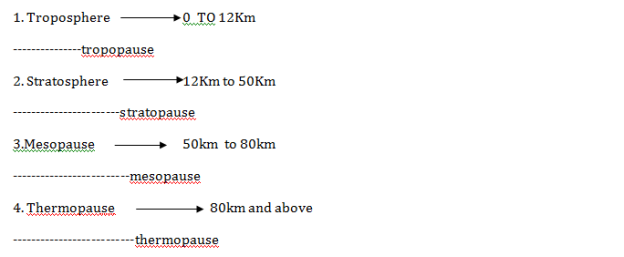 Classification of rocks
Classification of rocks
A rock is any naturally occurring consolidation of minerals particles that forms the earth’s crust giving it a solid nature.
The earth is formed by rocks in which some are hard while others are soft.
Rocks can be classified according to the following;
i) Mode of formation
ii) Their age or physical and chemical characteristics.
Classification of rocks according to their mode of formation.
According to the mode of formation, rocks can be classified into three classes;
a) Igneous rocks,
b) Metamorphic rocks
c) Sedimentary rocks
i) Igneous Rocks
The word igneous is derived from the Greek word Ignus meaning fire. Igneous rocks are rocks formed by cooling and classification of molten materials from the interior of the earth.
When the temperature increase inside the earth’s crust, the materials in it melt hence the materials are forced out by high pressure. The molten materials inside the earth are called magma. When magma penetrates and reaches the earth’s surface, it is called Lava.
Types of igneous rocks
i) Intrusive igneous rocks
ii) Extrusive igneous rocks
i) INTRUSIVE IGNEOUS ROCKS
These are found below/inside the earth’s surface. They are formed when molten materials called magma solidify inside the earth’s crust e.g granite.
Intrusive igneous rocks are further divided into two categories; that is;
a) Plutonic rocks
b) Hypabyssal rocks
a) Plutonic rocks
Are rocks formed by the magma that cools more rapidly on or near the surface of the earth and produces fine textile igneous rocks e.g basal. Other examples of plutonic rocks are granite, diorite and gabbro.
b) Hypabysal rocks
These are formed when magma is mixed with other rocks
These rocks occur vertically forms called dykes or horizontally called sill. Hypabysal rocks are finer than plutonic rocks e.g dolerite and pophyre.
ii) EXTRUSSIVE IGNEOUS ROCKS
These are rocks which are formed when the magma reaches the earth’s surface in form of lava. It occurs when there is volcanic eruption hence lava cools outside the earth’s surface.
Note that volcanic rocks are formed in two ways;
a) When lava flows to the surface before cooling and solidifying e.g basalt, andesite, rhyolite and absidian.
b) When lava is ejected during volcanic eruptions, e.g pumice
Summary
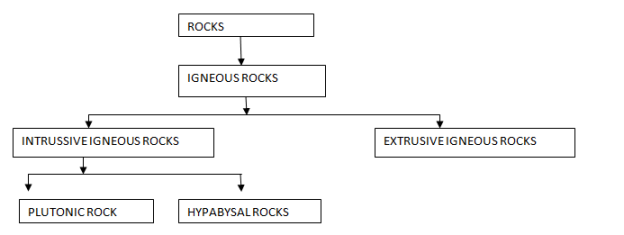
CLASSIFICATION OF IGNEOUS ROCKS BY THEIR CHEMICAL COMBINATION
According to the chemical composition, igneous rocks can be classified as follows;
A. Felsic (ACID) Igneous rocks
Are igneous rocks which contain great amount of silica and feldspar with very little or no any other metallic element. E.g granite, granophyres, rhyolite and absidian.
B. MAFIC(BASIC) Igneous rocks.
These are rocks which consists of large amount of magnesium, iron and other minerals like alluminium.
C. ULTRA-MAFIC ROCKS
These are igneous rocks which consists o very large amount of metallic elements like iron, magnesium and little amount of silica. Example is polidolite.
D.INTERMEDIATE IGNEOUS ROCKS
Are igneous rocks which contain silica content between basic and acidic degree. That is both basic and acidic properties in equal proportions.
Examples includes,dionite, poryphaces, and andesite.
CHARACTERISTICS OF IGNEOUS ROCKS
Are very hard and not stratified
Are formed by cooling and magnification of magma
Can be acidic or basic or intermediate depending on silica amount
They are crystallined in nature
May undergo metarmophisms to form metamorphic rocks
Contain minerals like iron and magnesium
May undergo weathering process and sedimentation to form sedimentary rocks
They don’t have fossils, that is, they do not contain fossils of animals remains.
Igneous rocks are called mother rocks because other rocks originates from them.
SEDIMENTARY ROCKS.
These are rocks which are formed by the process of sedimentation. Especially during weathering.
Sedimentation is the deposition and accumulation and lithification of sediments of some weathered rocks and other materials.
Particles or sediments are deposited by the following agents;
a) Moving air
b) Moving water
c) Ice
The materials are deposited in large strata to form sedimentary rocks.
Ways in which sedimentary rocks are formed;
They are formed in three ways;
i) Mechanically formed sedimentary rocks
are rocks formed by compaction and comentation of sediments which have been laid down on land or sea floor.
Mechanically formed sedimentary rocks are also called plastic rocks because they consists of fragments of rocks and rock minerals. Examples are;
i) Argillaceous rocks; they contain small amount and fine particles of silt e.g shale and mudstone.
ii) Auencieous rocks- These are rocks composed of medium sized particles like sand eg. Sand stone and grit.
iii) Rudaceous rocks; composed of large particles such as conglomerate (round shaped pebbles breccias) builder clay gravel and scree.
2. Chemically formed sedimentary rocks-
Others are formed chemically/ mixture of different minerals eg carbonates like traventure found in form of stalagmites and stalactaties. Due to precipitation of calcium carbonate.
Sulphates as a result of dessification and evaporation of rocks like gypsum in which hydrated calcium carbonate may be formed.
Characteristics of sedimentary rocks.
- They are stratified and young rocks layer overlying the old rock layers.
- They are non-crystallined which means they are not in form of crystals
- They contain fossils as a result of accumulation of skeletons and shells of once living organisms
- They may undergo changes to form metamorphic rocks
- Consists of some fragments which were once connected and deposited from rocks.
Sedimentary rocks are formed by deposition of clastic sediments organic matter or chemical precipitates, evaporates followed by compaction of particulate matter and comentation during diagenesis. Sedimentary rocks form near surface of the earth.
B. Organically formed sedimentary rocks-
Are formed by remains of once living organisms examples calcareous rocks like lime stone and skeleton.
These are also carbonaceous rocks formed from remains buried thousands of years under high pressure and temperature.
3. METAMORPHIC ROCKS
Metamorphic means change in appearance. They are rocks formed when one type of rocks-igneous or sedimentary change its form after being subjected to either intense heat pressure or both.
Any rock may undergo changes to form metamorphic rocks as shown below;
a) sedimentary rocks to metamorphic rocks,
e.g; Sandstone to quartize
Limestone to marble
Coal to granite
Mudstone to slate
Clay to Slate
b) Metamorphic rocks to metamorphic rocks
eg, Slate to schist
c) Igneous to metamorphic rock
e.g Augite to horn Blende
Granite to Igneous
Metamorphism is the process by which rocks of the earths surface change their appearance from one type to another type of a rock.
Types of metamorphic rocks.
i) Contact metamorphosis
It occurs when magma comes into contact with the existing rocks. It can be caused by movement of ocean waves or currents which comes into contact with the rock and eventually the rock breaks down.
The collision with other agents of erosion causes the following breaking down of rocks.
ii) Dynamic metamorphism
It is associated with fault planes. It is caused by the frictional heat generated by fault movements. This is due to crushing and grinding of rocks.
iii) Regional metamorphism.
Is the one which takes place in the large areas especially mountains ranges. It occurs due to the collisison of two continental plates hence high temperature and pressure lead to the disintegration of rocks from existing ones.
ECONOMIC IMPORTANCE OF ROCKS.
- Rocks provides building materials such as gravel, sand
- Some rocks creates employment opportunities to the people
- Rocks provides precious minerals like gold and diamond
- Some rocks provide energy which later used at home and in industries.
- Some rocks provide underground water
- Rocks are sources of soil for agricultural activities
- Some rocks attract tourists in the country bring foreign currencies.
THE GEOLOGICAL TIME SCALE
This is a scheme or a chart that indicates age classification of rocks and associated geo-morphological and biological events.
Division of Geological time time scale.
Geological time scale is divided into eras, period, epochs and ages.
Geological time scale extends about 600 million years and is divided into three eras;
a) Palaezonic Era
b)Mesozonic Era
c) Cainozoic Era
Among the above, eras, palaezonic is the oldest while cainozoic is the youngest.
The eras are subdivided into periods.
a) The geological time scale is divided into ERAS
b) The eras are further divided into PERIODS
c) The periods are then divided into EPOCHES
d) The epochs are eventually divided into AGES
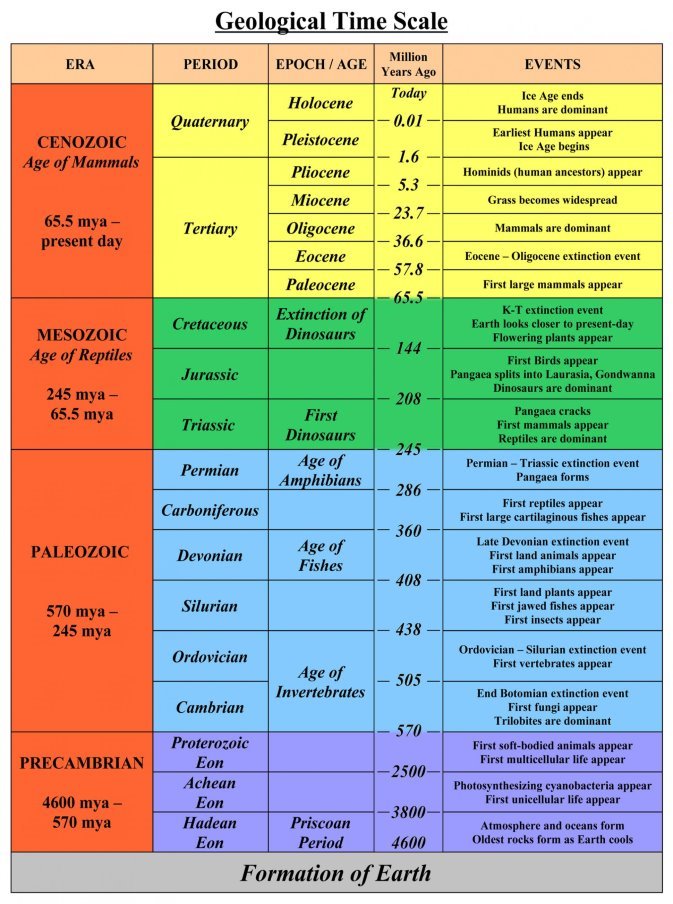
CHAPTER SUMMARY.
- Earth is the third planet in the solar system which is meant to support life.
- The earth consists of two parts; internal and external part.
- The earth has three parts; crust, mantle and core.
- Earth crust consists of SIAL and SIMA
- The core consists of outer core and inner core
- The external structure of the earth consists of earth’s surface, hydrosphere and atmosphere.
- The atmosphere is divided into five layers, examples are troposphere, stratosphere, mesosphere, thermosphere, exosphere and ionosphere.
- A rock is naturally occurring consolidation of mineral particles that forms earth’s crust giving a solid nature.
- Rocks can be igneous rocks, metamorphic rocks and sedimentary rocks.
- The igneous rocks is divided into two types which are extrusive and intrusive igneous rocks.
- The igneous rocks are called mother of all rocks
- Sedimentary rocks are formed by the process of sedimentation.
- Sedimentary rocks can be chemically formed or mechanically formed.
- Metamorphic rocks are formed when a rock changes its form.
- Metamorphic rocks can be by contact metamorphism, dynamic metamorphism, or regional metamorphism.
www.learninghubtz.co.tz
END OF CHAPTER QUESTION.
- Give a comprehensive division of the earth crust
- Describe the concentric zones of the earth
- Mention the three types of rocks and explain how they are formed
- Why igneous rock is called the mother of all rocks?
- Describe the economic importance of rocks
- Explain the characteristics of sedimentary rocks
- What are metamorphic rocks? Give examples
- Explain why the earth is unique from other planets
- Describe the layers of earth’s atmosphere
- What mineral elements make up the core?
Hub App
 For Call,Sms&WhatsApp: 255769929722 / 255754805256
For Call,Sms&WhatsApp: 255769929722 / 255754805256
 For Call,Sms&WhatsApp: 255769929722 / 255754805256
For Call,Sms&WhatsApp: 255769929722 / 255754805256
WHATSAPP US NOW FOR ANY QUERY
App Ya Learning Hub Tanzania






